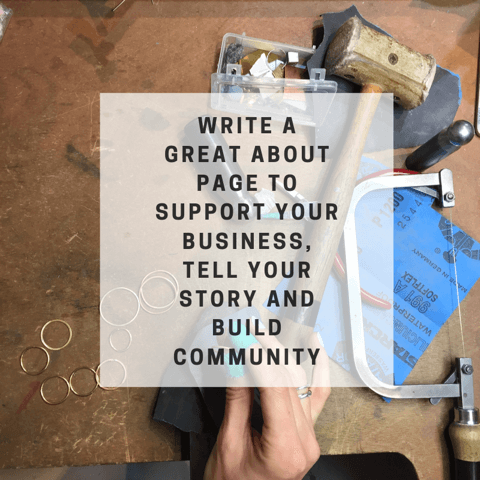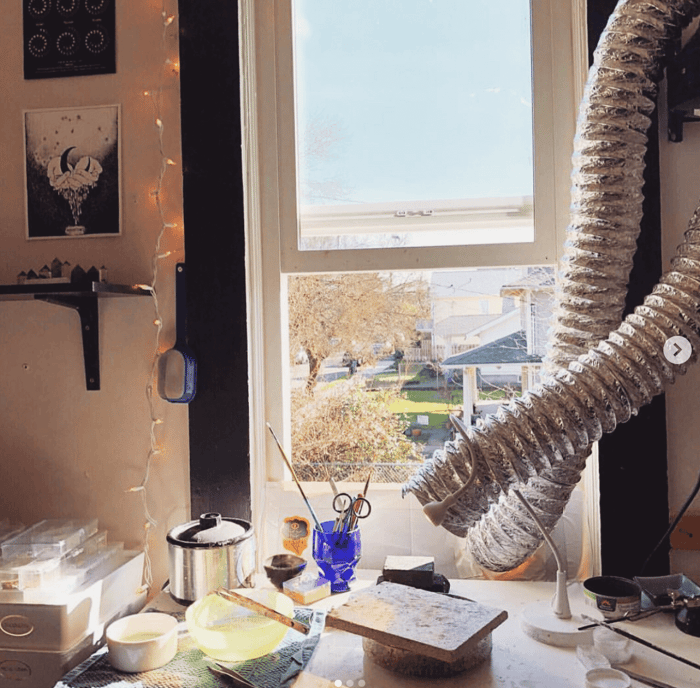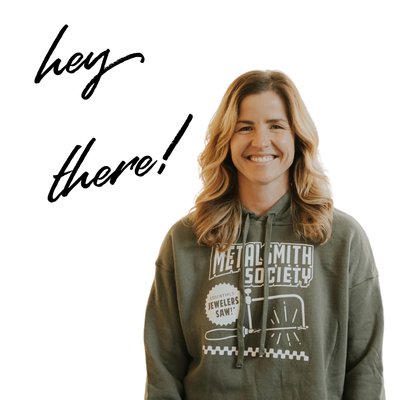
One of the most important pages on your website is your About page, it is a place to tell your story and an opportunity to attract dream customers and build community! This blog article was written by Rebecca Enderby. Rebecca is a researcher, writer, and yoga teacher who loves making jewelry.
An About page on your website is a place for your dream customers get to learn about who you are, what you do, and why you do you what you do. The About page tells your brand story. It is often the first step to building a relationship with new customers and to build your community.
But does writing about yourself and what you sell feel overwhelming, hard, or a little icky? I hear you! And you are definitely not alone on this. But a well written and engaging About page is super important for your business. Sales allows you to grow your business, so you can keep serving you dream customers and community. And do this this you need an About page.
Try shifting from seeing it as having to write about you, ‘show off’ your skills or talents or be salesy. See it as an opportunity to build a relationship with a person, and to build your community, build trust and communicate your values. All this is what then leads to more sales.
Before we get into it let's clarify the difference between an artist bio, artist statement and About page.
Your artist bio is like your résumé in paragraph form. It highlights your top accomplishments, usually starting with the most recent and most important. It gets to the point. It is not a place for you to share everything you have ever done or get into your personal life.
You write your bio in the third person unless it's an autobiography, in which case you'd use the 1st person.
Your artist statement is about your art, not about you. More to the point, it's about the current direction of your work, not a history of how you got to this point. It is written in the first person.
The About page on your website is where your artist bio and statement come together. There should be text about both you and your art on this page. It should be less formal than the proper bio you would use to share with a museum or gallery. How you approach your About page depends on your goals as an artist/designer-maker. For a maker looking to sell, an effective About pages is often the starting point for a sale or other action. It starts to builds a relationship with your dream customer. The following tips are for jewelry designers/makers that want to sell their work or service.
Here are 7 great tips for writing an About page that tells your brand story and attracts your dream customers:
1. It’s not actually all about you
Make it customer focused! The About page is where you get to introduce yourself as the face behind the brand for the very first time. But you should see it as the place for you to connect with a potential new customer. This is where you tell people about you and your work, but relate your story back to the customers you want to serve. Ask yourself, how does what I do/make help my customer? This helps to build a sense of trust and respect with that person and create a loyal customer. Keep thinking about your ideal client(s) when writing your about page. Check in to see if you are writing in way that would resonate with them (not you).
2. Write in the first person
Writing in the third person is still correct and many people still do it. But writing in the first person makes it more personal and engaging. If you are starting out try writing in the first person and see how it feels.
3. Open with something compelling about you!
Start with an opening line that’s interesting and reflects something about you. There is no need to go straight into your education or your inspiration. Is there something that people say about you and your work? Do you have a specific outlook on life or work that you've learned though experience? Get people’s attention and show a little about who you are.
4. Tell a story
Think of your About page as a story, rather than using bullet points, a resume-style or a series of facts. Keep it conversational and light. Storytelling helps add context to the goals and mission of your business. Make it fun! This builds a stronger connection to your customer or community. It also makes the page more enjoyable and interesting to read. A great tip is to add in questions that connects you to the reader and/or helps the reader feel understood. It also gets them to refocus. Be careful not to make it too long - your customers don't need to know every detail about your life! Edit your story down to the colorful bits. Make it short and clear, but bold and compelling. Use short sentences, and avoid jargon, technical or business language. This language can alienate people that are not familiar with these terms.
5. Add personality and your unique selling point
Even though you’re using simple language, you can still add some personality to make it more engaging. Write like you speak, keeping it conversational and personable. There are lots of designer out there and many have similar looks and processes. But none of them are you. And your dream clients want to buy from you! Highlight why you are different, in your processes, your values, and your aesthetics. Examples: You only work with ethical and sustainable materials or use complex, unique processes. You are a long-established family-run business or you give back to the community in some way. Your unique selling points will attract more of your dream clients. Add a couple of sentences about what you and your business doesn't do, that others might. What values or processes make you different form other jewelers.
6. Have a call to Action (CTA)
When written well, an About page should keep readers hooked until the end. Then you should give them something else to do, known as a call to action (CTA). A CTA keeps the conversation and connection going. It can also serve as a way for interested readers to stay in touch with your brand (e.g. through a newsletter). A CTA could be ‘Shop Now’ button, or an invitation to join your newsletter. It could be a link to read your blog or follow you on social media. Without a call to action on this page, you risk customers leaving. A CTA keeps the conversation going a little longer and helps build relationships (and sales).
7. Add a photo!
When your written content is brief, a picture is a great way to add more personality and heart. It is important to add a human element so that you can build connection and community. Add a (high-quality!) image of you or your team. You can add one of you at your bench, in your studio or with something that inspired or influences your work. If you take inspiration from nature you could include of photo of you in your favorite nature spot. Or have a photo with your pets! Let people see the person or people behind the brand.
Thank you so much for sharing these tips with us Rebecca, you can give her a follow on Instagram @enderbyyoga!
Hope you found this article helpful! Be sure to check out my article about pricing your jewelry line!





